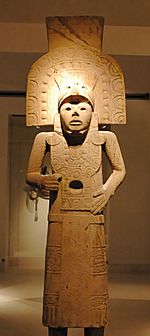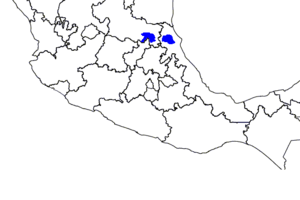Balcón de Montezuma facts for kids
Quick facts for kids Huastec Culture – Archaeological Site |
||
| Name: | Balcón de Montezuma archaeological site | |
| Type | Mesoamerican archaeology | |
| Location | Cd. Victoria,Tamaulipas |
|
| Region | Mesoamerica | |
| Coordinates | 23°35′27″N 99°10′41″W / 23.59083°N 99.17806°W | |
| Culture | Huastec or Wastek | |
| Language | Wastek language | |
| Chronology | 600–900 CE | |
| Period | Mesoamerican late classical | |
| Apogee | ||
| INAH Web Page | Balcón de Montezuma archaeological site | |
Balcón de Montezuma (pronounced bal-KOHN day mon-tay-SOO-mah) is an ancient site where people once lived. It's also known as "Balcon del Chiue." You can find it about 18 kilometers (11 miles) south of Ciudad Victoria in Tamaulipas, Mexico. This important place is part of the Huastec civilization.
It's located in a small town called Alta Cumbre. The site is about one kilometer north of Highway 101, which goes towards San Luis Potosí. Balcón de Montezuma is also about 203 kilometers (126 miles) northwest of another Huastec site called Las Flores.
Contents
A Look Back in Time
The land of Tamaulipas has a very long history. The first people lived here about 12,000 years ago! They were found in a place called "complex Devil" in the Sierra of Tamaulipas mountains. Later, around the middle of Tamaulipas, people started farming. They learned to grow corn, which helped them settle down in one place. This is when the first signs of advanced cultures, known as Mesoamerican cultures, appeared in this area.
Before the Spanish arrived, many different groups lived in Tamaulipas. One of these groups was the Wastek people. A famous mapmaker named Amerigo Vespucci visited this area in the late 1500s. He wrote that the native people called their land "lariab." Later, during colonial times, the area had many different names. The name "Tamaulipas" comes from "Tamaholipa," a name given by Fray Andrés de Olmos in 1544.
The Huastecs in Tamaulipas mostly lived near the Guayalejo River and in mountain valleys. They didn't have one big kingdom but rather many smaller leaders. They were very skilled artists and had complex religious beliefs. In fact, the idea of the important god Quetzalcoatl may have started in the Huastec area. Even though they were a strong culture, the Mexicas later took control of some parts of the Huastec land.
Balcón de Montezuma is a great example of the Huastec people's building skills. It shows how organized their society was. Other Huastec sites, like Sabinito, are still being studied today.
How the Culture Grew
In the Tamaulipas mountains, archaeologists have found three main periods of Mesoamerican culture. These are called Laguna, Eslabones, and Salta. They cover a long time, from 650 BCE to 1000 CE.
At first, small villages appeared in the mountains. These villages had up to 400 homes built around open areas and platforms. There were also small circular buildings. But around 500 CE, this culture became very strong. Their towns grew to have up to a thousand houses, often built on hilltops. These towns had small pyramids in the center. The way the towns were planned suggests they had a government, possibly led by religious leaders. Pottery found here shows they traded with other important Mesoamerican areas.
Who Were the Huastecs?
The Huastec people are a native group from Mexico. They lived in the states of Hidalgo, Veracruz, San Luis Potosí, and Tamaulipas. Their main area was along the Pánuco River and the coast of the Gulf of Mexico.
The ancient Huastec culture is believed to have started around 1000 BCE. Their most active period was during the Postclassic era. This was after the fall of Teotihuacan and before the rise of the Aztec Empire. The Huastecs built temples on pyramids with steps. They also carved amazing sculptures and made beautifully painted pottery.
The Huastecs were known for their advanced culture and cities. Interestingly, they often didn't wear much clothing. Other Mesoamerican people admired them for their musical talents.
The Huastecs arrived in northern Mesoamerica between 1500 BCE and 900 BCE. We know this from both their language and archaeological finds. In 1954, a researcher named Richard Stockton MacNeish found pottery and figures from the early period of the Huastec culture. These items were similar to those found at an ancient Maya site called Uaxactun. It seems most likely that the Huastecs arrived in their current area around 1100 BCE.
The Huastec Language
The Wastek or Huastec language is a Mayan language spoken in Mexico by the Huastecs. Even though it's far from other Mayan languages in Mexico and Central America, it's still related to them.
The people who speak this language call it Teenek. This name has become more common in Mexico and around the world recently. An extinct language called Chicomuceltec language is thought to have been very similar to Wastek.
The first person to write down a description of the Huastec language for Europeans was Andrés de Olmos. He also wrote the first grammar books for the Nahuatl and Totonac languages.
What's in a Name?
The name Tamaulipas (pronounced tah-mah-oo-LEE-pahs) probably comes from the Huastec word Tamaholipa. The part tam- means "place where." However, experts aren't sure what holipa means. Some think it means "high hills" or "place of olives."
Studying the Site
Archaeologist Jesus Nárez explored and restored Balcón de Montezuma between 1989 and 1990. His research helped us learn a lot about the ancient people who lived here. We know that their houses were like huts with palm roofs, built on top of circular stone bases. When people died, they were buried under the floors of their homes. In the 1980s, many human skeletons of both children and adults were found.
Balcón de Montezuma shows us what small farming villages in the mountains were like during the Late Classic period (600–900 CE) of Mesoamerican history.
The Site Itself
This ancient village existed from about 400 to 1200 CE. It has around 90 circular bases, which are grouped into two small, semi-circular plazas. The site is located high up in the Sierra Madre Oriental mountains, about 1,200 meters (3,937 feet) above sea level.
The buildings and styles at Balcón de Montezuma show connections to human groups that lived in the Sierra Madre Oriental and the Sierra de Tamaulipas. Their culture shared features with both the Huastec culture and groups from the Southwestern United States.
So far, no images of their gods have been found at the site. We also don't know if any of the buildings were used as temples. The main way to enter the site was through a large staircase with more than 80 steps. This staircase was built into the natural limestone hills on the western side.
What the Structures Look Like
The site has over 70 circular structures. They are all different sizes and heights and are grouped into two small, curved plazas. These bases were built using limestone stones, stacked without mortar. The inside of the bases was filled with dirt, small stones, and pieces of pottery.
These structures are unique. Some have small stairways with 3 or 4 steps, which are either set back or built on top of the main base. The bases are shaped like a fan. Experts believe these circular bases were the foundations for houses. The walls of these houses were likely made of bajareque (a mix of mud and sticks), and the roofs were made of palm leaves.
Archaeologists also found traces of stone slabs that were used as paved surfaces.
The items found at the site tell us about the people's daily lives. They used smoking pipes and crystal quartz, perhaps as good luck charms. They also wore necklaces and used stone disks. As mentioned, they buried their dead under the floors of their houses, often with pottery as offerings.
Images for kids
See also
 In Spanish: Balcón de Montezuma para niños
In Spanish: Balcón de Montezuma para niños







